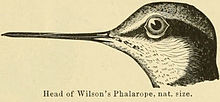Wilson water treaders
| Wilson water treaders | ||||||||||
|---|---|---|---|---|---|---|---|---|---|---|

Wilson water treaders ( Steganopus tricolor ); Females in splendid dress |
||||||||||
| Systematics | ||||||||||
|
||||||||||
| Scientific name | ||||||||||
| Steganopus tricolor | ||||||||||
| Vieillot , 1819 |
The Wilson water treadmill ( Steganopus tricolor , Syn . : Phalaropus tricolor ) is a species of bird from the family of snipe birds . The first description comes from Louis Pierre Vieillot and is dedicated to the American ornithologist Alexander Wilson .
In Central Europe, the Wilsonwassertreter is a rare errant. For example, in the Netherlands between 1966 and 2003, individual individuals were seen a total of twenty times.
Systematics
The Wilson water treaders were formerly settled within the plover-like family Phalaropodidae (or Phalaropidae) together with the Odin's chickens and the Thor's chickens . Here one assumed a relationship with the avocets . Today, based on several morphological and molecular genetic analyzes, there is no doubt that water treaders belong to the snipe birds . Due to their different characteristics, they are still often listed as a separate subfamily Phalaropodinae within the snipe birds. For the Wilson water treadmill or American Odinshickchen ( Steganopus tricolor ), which is sometimes assigned to the genus of the water treaders ( Phalaropus ), the assignment to the genus Steganopus is now common.
distribution
The Wilson treadmill breeds in the prairie landscapes of North America and is found mainly in western Canada and the USA . It is a migratory bird and winters in South America . Occasionally it happens that birds of this species are also expelled to Europe during their migration.
The Wilson Treadmill is often seen at brackish and salt lakes such as Mono Lake in California and the Great Salt Lake in Utah during its migration period . During this time it is often kept with the Odin's chicken.
Appearance
The body length of the Wilson water treadmill is approximately 23 centimeters. It is characterized by a straight, fine black beak. The female is predominantly gray and brown in color on the upper side of the body in its magnificent dress. The underside of the body is white; the neck is reddish and there are also reddish spots on the flanks. The male resembles the female; however, the colors are less bright.
Way of life
Similar to the water treaders , the roles usual with birds are reversed. The females actively woo the males, fight for breeding grounds and aggressively defend their nests and their chosen sexual partner. Once the females lay their eggs, they begin migrating south. The males then incubate the clutch, which consists of three to four eggs.
When foraging for food, Wilson Treaders often swim quickly in small, tight circles, creating a kind of small whirlpool . This behavior is generally interpreted to mean that the bird succeeds in bringing food to the surface. It is mainly small animals, including insect larvae, that are taken out of the water.
supporting documents
literature
- Otto Höhn: The water treaders (Phalaropodidae) . Ziemsen, Wittenberg 1965, ISBN 3-89432-753-7
- Josep del Hoyo et al .: Handbook of the Birds of the World. Volume 3: Hoatzin to Auks. Lynx Edicions, 1996, ISBN 84-87334-20-2 .
- Bernhard Grzimek: Grzimeks Tierleben , Volume 8 ( Birds 2 ). Kindler, 1969, ISBN 3-8289-1603-1
- Stanley Cramp , David Snow : The Complete Birds of the Western Palearctic. Oxford University Press, 1998, ISBN 0-19-268579-1 .
Web links
- Videos, photos and sound recordings for Steganopus tricolor in the Internet Bird Collection
- Steganopus tricolor inthe IUCN 2013 Red List of Threatened Species . Listed by: BirdLife International, 2012. Retrieved September 3, 2013.
Single receipts
- ↑ Hans-Günther Bauer, Einhard Bezzel and Wolfgang Fiedler (eds.): The compendium of birds in Central Europe: Everything about biology, endangerment and protection. Volume 1: Nonpasseriformes - non-sparrow birds , Aula-Verlag Wiebelsheim, Wiesbaden 2005, ISBN 3-89104-647-2 , p. 488
